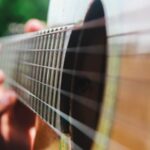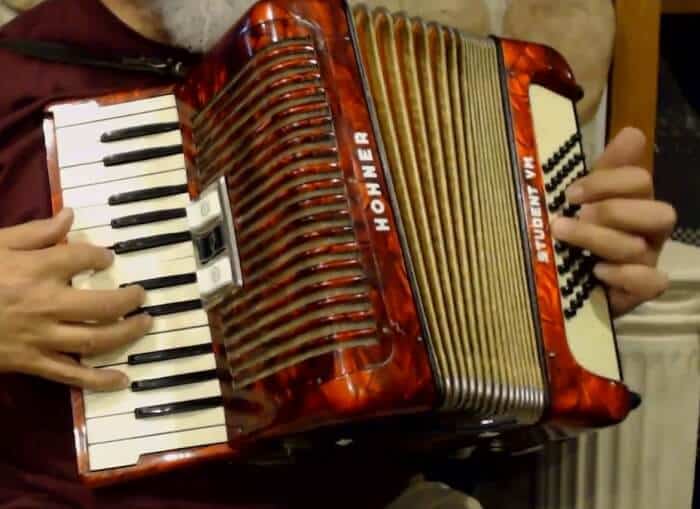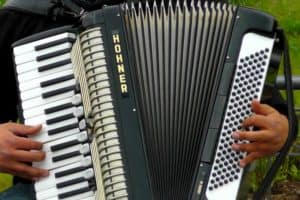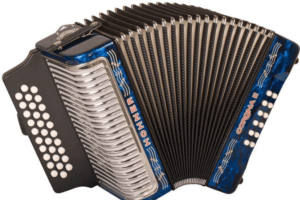Learning how to play the accordion, like any instrument, takes practice. Some people, when they see an accordion, think it looks rather confusing or daunting. The button accordion can be especially hard to play compared to the more familiar-looking piano accordion.
How hard is it to learn accordion? It isn’t too hard to learn the accordion. With daily practice, you should start to get comfortable in about 3 or 4 months. The hard part about learning how to play accordion is making your hands work independently – pressing the keys and buttons while moving the bellows back and forth.
Read on to learn more about how hard it is to learn accordion and tips for teaching yourself how to play it.
We hope you find the links here useful. We may get a commission if you purchase something through a link on this page, so thank you!
Also, for an excellent accordion, take a look at our top pick, the Hohner 3100GB Panther Diatonic Button Accordion:
Click here to see it on Amazon.
How Hard Is It to Learn Accordion?
As you might know, there are two main types of accordion: the button accordion and the piano accordion.
Piano accordions, as the name suggests, have keys just like a normal piano. The keys produce the same sound whether you pump it in or out. If you already know how to play the piano, it will be easier for you to learn how to play a piano accordion.
Button accordions, which are also called Irish or Cajun accordions, have buttons that play a different note, depending on the manner you squeeze the bellows (in or out). What makes button accordions harder to play than piano accordions is that you are required to memorize all the buttons.
However, once familiar with the buttons, musicians usually find the button accordion easier to play than piano accordions. The reason for this is that the buttons are smaller and closer together than the piano keys on a piano accordion. And because of this close proximity, it’s easier to transition from low notes to high notes on a button accordion.
Another factor that can make it hard to learn the accordion is the fact that aside from the keys or the buttons on the right, there are also buttons on the left side. The buttons on the left, no matter how many there are, are designed as follows: first and second rows are bass notes while the rest of the rows of buttons or keys are for chords and are usually arranged: C, F, B-flat, E-flat, A-flat to the left, and C, G, D, A, E to the right.
Some guitar players find the chromatic button accordion easier to learn due to the basic chords and scale patterns that require almost the same fingering manner as guitar chords and scales.
Self Taught Vs Taking Accordion Lessons

A teacher or a music instructor who knows a lot about the accordion can definitely be advantageous. Unfortunately, despite the accordion’s popularity in a lot of countries, including Europe and the U.S., there aren’t many instructors who teach how to play it. So the probability of finding a good teacher who can teach you how to play accordion is quite slim.
If after searching you still haven’t found a teacher, worry not because I’m here to help you out!
For starters, here are 7 tips that will speed up the time it takes for you to learn how to play the accordion:
1. Buy the Right Accordion
To learn the accordion quickly and in a more enjoyable manner, it is important to buy an accordion that is best for you, depending on different factors. These factors include your height, budget, age, as well as the musical style you want to play.
If you know how to play a piano, then it will be easier for you if you get the piano accordion. However, if you’re a guitar player, then a chromatic button accordion might be best for you. See my article on choosing piano or button accordion to learn more about deciding between a piano or button accordion.
An accordion with fewer buttons and treble keys will, of course, be easier to learn than an accordion with more buttons and keys. I recommend starting out with an accordion with fewer buttons and keys so that you don’t get overwhelmed.
Below are some accordions that are great for beginners. They are lighter in weight, more affordable, and built to last. Any of the below accordions will make your journey to learn the accordion that much faster and more enjoyable.
Hohner 3100GB Panther Diatonic Button Accordion
Click here to see it on Amazon.
The Hohner 3100GB Panther Diatonic Button Accordion is a compact and lightweight accordion with 31 treble keys and 12 bass buttons that let you play in G, C, and F keys. This can be your perfect partner while you are still beginning because of its lightweight and user-friendly design.
Wal Front 22-key, 8 Bass Beginner Piano Accordion
Click here to see it on Amazon.
The Wal Front Beginner 22-key, 8 Bass Piano Accordion, as the name suggests, is highly suitable for beginners due to the ease of playing it. This accordion, which has 22 keys and 8 bass buttons, is made of light maple wood and comes in different colors such as blue, red, and green. This accordion weighs only about 7.5 lbs.
Hohner 3100FB, Panthers, 3-Row FBE Diatonic Accordion
Click here to see it on Amazon.
The matte-black Hohner 3100FB, Panther, 3-Row FBE Diatonic Accordion is another perfect choice for accordion players, new or experienced.
This Hohner accordion has quality features such as 31 treble buttons (across 3 different rows), 12 bass/chord buttons, and two sets of treble reeds. This accordion also comes with double-strap brackets to help you support its weight (9 lbs).
Hohner BR48R-N 26-Key Piano Accordion
Click here to see it on Amazon.
The Hohner BR48R-N 26-Key Piano Accordion is a bit heavier than the other accordions but still lighter compared to more premium accordions. It weighs about 15 lbs with 26 keys, 48 bass buttons, two-tone colors, two treble registers, and four standard bass voices.
With this accordion, the musical styles you can play are definitely not limited. You can play Jazz, Irish Folk, Zydeco, Tejano, Conjunto, Polka, Traditional, American Folk, Tex-Mex, Norteno, Irish Folk, Traditional English music, Marches, Polka, Italian, Latin, Tango, Cajun, and more.
2. Familiarize Yourself with Your Accordion
After buying your accordion, make sure that you are familiar with the structure of your instrument. This way it’s less likely that you’ll break it, and you will be able to maximize its potential.
To do this, try to search for available resources such as videos on the internet, or books about techniques, or instruction manuals on how you can learn to play accordion easier. Also, try to look for a Stradella chart – this chart can help you have a mental map of the keys/chords present on the left side of your accordion.
To jumpstart your familiarity with your accordion’s structure, here are some of the accordion’s parts and their functions:
Bellows
Bellows are said to be the soul of any type of accordion. These are the folds on the accordion that are usually made up of paper, cloth, or cardboard with either leather or metal used for strength. The main function of bellows is to supply air making it possible to produce sounds.
Melody Keys
Melody is produced by either squeezing the buttons or pushing your keys present on the right side of your accordion.
Register Switches or Couplers
When you press these switches, you’ll find yourself listening to a different tone on your accordion. Usually, a switch is present on both sides of your accordion.
Air Valves
Air valves allow you to let air escape from your bellows without making any sound.
Button Keys
Button keys on the left side of your accordion are the ones that make the harmony you hear whenever you are playing or listening to an accordion.
3. Hold Your Accordion Correctly
The way to hold your accordion is by placing it on your chest with the keys/key buttons away from you. Your accordion’s straps will help you maintain this position.
Although some prefer playing the accordion while standing, this manner of playing could tire you easily, especially with a heavy accordion. The most important thing here, however, is choosing the position that allows you to easily control your accordion while being comfortable. Whether you’re comfortable playing your accordion while standing or sitting, always remember not to slouch since this might cause you to play inaccurately.
Whether you choose to stand or sit, make sure that your strap is tight enough that your instrument won’t slip while playing but loose enough that blood on your shoulders can still circulate. Invest in a backstrap – a strap that connects the shoulder straps on your back to avoid a heavier accordion from slipping off your body. A backstrap can be advantageous in the long run, especially if you’ll be standing for a while playing.
If you prefer to sit down while playing your accordion, it is important that you choose a seat that allows you to touch your feet on the ground. This way, you can have the control that you need while playing.
4. Play Your Accordion Correctly
Now, how do you start playing your accordion? Here are the simple steps you can follow:
Make Your Right Wrist Positioned Parallel to the Keyboard
Make sure that you don’t over-bend your right wrist. Beginners often make this error and can lead to poor fingering and possible injury in the long run. It’ll be difficult at first, but you’ll be comfortable with this position as you practice more.
Have Your Left Hand Positioned Between the Strap and Bass Button
You can curl your fingers freely in this position to make harmonies from the bass buttons.
Push the Air Valve
You can find the air valve button near the strap and bass buttons. When you push the button, you’ll be able to hear a noise similar to hissing. This noise is a result of the air entering the accordion and bellows.
Push Your Bass Buttons Softly Then Pull Your Bellows
Don’t push your bass buttons too hard. As stated earlier, these buttons are for chords/bass notes. A mental picture of your bass buttons will come in handy in this step because if you’re maintaining a proper posture, then you won’t be able to see your left-hand fingers.
After conjuring your mental picture of the bass buttons, try to put your index finger on the C note while placing your thumb on the C major chord. Alternately push these two buttons while pulling your bellows.
Try to Play the Key Buttons While Playing the Bass Buttons
The skill that will come in handy in this step is the exercise you’ve done on a separate piano or keyboard. Remember that coordination will be hard at first. But with more practice, you can definitely learn how to play accordion by yourself.
See this video for more tips on how hard it is to learn the accordion, as well as practice tips.
5. Take Short but Frequent Practice Sessions
Getting frustrated with learning a new instrument will be avoided if, instead of doing long, irregular practices, you’ll do a short but regular practice. After a few weeks, you will be used to playing regularly. You won’t burn out from long sessions of playing.
6. Practice on a Keyboard to Train Your Right Hand
If you choose a piano accordion, practice on a keyboard or piano. To build the strength and the ease by which you can play the right side of your piano accordion, you might want to train your right-hand fingers by speeding up your playing on a keyboard.
7. Properly Maintain Your Accordion
As a beginner, it is also important that you know how to properly care for your accordion. The below tips will help you maintain the quality of your accordion for many years:
Keep Your Accordion in a Warm, Dry Room
Exposing your accordion to an extremely hot or cold temperature will damage the reeds of your accordion. Always make sure that your accordion is placed in a warm and dry room.
Carefully Transfer the Accordion to and from Your Case
Lift your accordion with care. Failing to do so could damage the bass and treble keys. The opposite is true as well; carefully lower your accordion where you keep it, even if it’s inside your case because suddenly dropping it would likely dislodge the blocks of reeds or destroy the valve and bass mechanisms.
Do Not Leave Your Accordion in a Place Easily Reachable by People
All too often, damage (caused by a sudden bump or drop) on musical instruments is done by other people. To avoid this, keep it in a place not easily accessible by other people.
Always Put Your Accordion in a Case
This way, even if it’s suddenly dropped or knocked over, there’s still a case that could break your accordion’s fall.
This video explains how hard it is to learn how to play the accordion, including several tips for playing:
Conclusion – How Hard Is It to Learn Accordion?
How hard is it to learn accordion? Learning the accordion, like any instrument, isn’t too hard if you practice enough. The hard part of learning the accordion is learning how to push and pull the bellows while fingering the buttons and keys. With regular practice or a few months, you’ll learn how to play the accordion at a more comfortable level.
Follow these 7 tips to shorten the time it takes to learn accordion:
- Buy the Right Accordion
- Familiarize Yourself with Your Accordion
- Hold Your Accordion Correctly
- Play Your Accordion Correctly
- Take Short but Frequent Practice Sessions
- Practice on a Keyboard to Train Your Right Hand
- Properly Maintain Your Accordion
Related reading:













